
Wine Culture and Information since 2002 - Volume 22
 Wine Culture and Information since 2002 - Volume 22 |
|
Issue 174, June 2018 |
Contents |
|
|
Happy Birthday Verdicchio! |
|
Verdicchio dei Castelli di Jesi, prestigious Denominazione d'Origine Controllata area of the Italian Marche region, this year – 2018 – celebrates its fiftieth anniversary. A history began in 1968 and that has always been one of the most important denominations of Marche region, undoubtedly one of the most extraordinary white wines in Italy. Fifty years which marked Marche's enology and that, after many revisions and modifications made to the production disciplinary, in 2011 it reached DOCG (Denominazione d'Origine Controllata e Garantita, Controlled and Guaranteed Denomination of Origin) for the Riserva style. The history of Verdicchio is evidently much longer than the fifty years of the Denomination of the Castelli di Jesi, having a strong, solid and deep connection to the Marche region and, moreover, it is a prestigious representative of Italian wine. The success of Verdicchio was the result of the work of many protagonists that have given this grape fame and notoriety, among them – undoubtedly – Sartarelli winery of Poggio San Marcello, in province of Ancona. This winery undoubtedly is, since many years, at the top of Italian wine scene with its famous Balciana, a Verdicchio which, undeniably, has marked a new extraordinary page of history for the great white grape from Marche region.
I had the privilege, and of course the pleasure, of tasting the first vintage ever produced of Balciana – 1994 – and that wine changed, for the better, my personal idea of what Verdicchio was. It happened in a restaurant near Spoleto, where I used to go at those times and which, fortunately, had a good and rich wine list. The owner of the restaurant told me he had added a new wine to the list, saying it was excellent, and he would have wanted me to try it. I asked what wine was, by whom it was produced and with what grapes: he replied it was produced by a winery in Marche with Verdicchio grapes. A Verdicchio different from all the rest, he said. I admit I didn't take him seriously – despite he was insisting on it very much and with a serious conviction in wanting me to try this wine – also for the fact, at that time, most of the wines produced with Verdicchio didn't seem to be particularly exciting to me. Let's make this clear: in that period – the middle of the 1990s – there were some magnificent Verdicchio, although they were few, maybe very few, and the majority was quite ordinary. This was not the case of Balciana. That Verdicchio dei Castelli di Jesi Classico Superiore Balciana was very different, it was a Verdicchio like it had never been poured into the glasses before. That Balciana 1994, as I have repeatedly said in the many occasions in which I spoke about this extraordinary wine, marked the beginning of the revolution of Verdicchio and the name of the Castelli di Jesi. More precisely – and better said – it relaunched the revolution of quality Verdicchio, proving the huge potentials of this magnificent white grape from Marche region. In this regard, Sartarelli winery is to be praised for its total and strong commitment to Verdicchio, as it is the only variety cultivated in their vineyards and with which makes five wines. Five different Verdicchio wines, each having its own precise and exact personality, all produced using only inert containers, no cask are used in this winery. To celebrate the fiftieth anniversary of the famous denomination of Marche, the last 20 April the Sartarelli family organized the interesting conference “Verdicchio dei Castelli di Jesi, history and future”. The conference was held at the “In Verdicchio Veritas” museum founded by the Sartarelli family in their own estate. In the suggestive setting of the museum, the conference had the contribution of local authorities and experts who focused on the story of Verdicchio in the territory of Castelli di Jesi. Of particular interest, the interventions dedicated to the history and viticulture of Verdicchio, in order to clarify the origins of this extraordinary white grape. As it is known – in fact – Verdicchio is supposed to be introduced in the Marche region by settlers from Veneto in the late 1400s, invited by the municipality of Jesi with the aim of repopulating the countryside after the disastrous plague epidemic. The grape they introduced is supposed to be Trebbiano di Soave, also confirmed by recent DNA research conducted on the two varieties which highlighted a strong analogy as well as a genetic relationship. The adaptation occurred in the territory of Jesi in the course of the centuries has led to the Verdicchio of our days, capable of making white wines of extraordinary magnificence, among the most prestigious white wines in Italy. The adaptation has been substantial and significant, so much so as to consider today Verdicchio, undoubtedly, as an autochthonous variety of Marche, a characteristic also confirmed by the evident differences existing between the wines made with the two grapes. Verdicchio, in fact, has found in the territory of the Castelli di Jesi its preferred place and given the birth to a unique and magic union. Wines belonging to the denomination “Verdicchio dei Castelli di Jesi” always gets both the favors and positive comments from the international wine critics, placing the wines of the famous white grape from Marche to the Olympus of world enology. Verdicchio undeniably is a variety having a huge enological versatility. This certainly in confirmed by the production of Sartarelli winery, consisting in five wines, all produced with Verdicchio – the only variety found in the estate's vineyards – five different wines with a distinctive personality and quality. From sparkling wine Charmat method to passito, including three other styles, among them, the prestigious Tralivio and Balciana – Sartarelli's production is also the evident proof of Verdicchio's enogastronomical versatility. This aspect, not less important than wine making, was in fact discussed during the conference that took place at Sartarelli's “In Verdicchio Veritas” museum, in particular with the cuisine of Marche. In these fifty years the history of Verdicchio dei Castelli di Jesi has been enriched by significant pages – and certainly many more are waiting to be written – transforming Verdicchio from ordinary wine to a giant of Italian enology. Happy birthday Verdicchio, undisputed king of Castelli di Jesi! Antonello Biancalana
|
||||||||||||
Contrasts of Schioppettino and ZinfandelFriuli Venezia Giulia meets California by comparing two of the most famous grapes in their respective territories |
|
Most of the times the comparison of extremely distant wines, not only in terms of organoleptic qualities, but above all in geographical terms, gives extraordinary surprises for the knowledge of the nectar of Bacchus. The characteristics given by the environment in which the vine is grown up and, not less important, the enological culture of the producers, can substantially change a wine, even in case it is produced with the very same grapes. This is not the case of this month's tasting by contrast, in fact we will not compare wines made with the same grapes and produced in different places, indeed, the two varieties subject of our study do not have anything in common. Likewise, their origin is different as well as and the wines of our tasting by contrast are produced in Friuli Venezia Giulia and in California. In our glasses we will in fact pour Schioppettino, interesting variety of Friuli Venezia Giulia, and Zinfandel, the glory of California, and where it is now considered an autochthonous grape. Two very different climates clearly influencing the wines produced in their respective territories. This aspect can be particularly evident in Zinfandel – this is the name by which Primitivo grape is known in the United States of America – when compared to the Apulian production. A comparison which cannot be made with Schioppettino as this variety is practically found in Friuli Venezia Giulia and Slovenia only. Varieties having quite opposite characters, both grapes show in any case a good wine making versatility, giving proof of appreciable wines both in inert and in wooden containers. From an organoleptic point of view, Schioppettino and Zinfandel give decidedly opposite sensations: appreciable crispness in the variety from Friuli, roundness in the Californian one. The structure of wines produced with these varieties are significant as well: body of medium structure in Schioppettino, a structure that can even become robust in case of Zinfandel.
|
|
The story of Schioppettino – also known as Ribolla Nera or, in Slovenia, as Pokalza – is very singular and, in some ways, even surreal. It should be noticed that in 1976, Schioppettino underwent the same fate of Pignolo and Tazzelenghe grapes when they were all declared outlaw, thus prohibiting the planting of new vineyards. This measure was fortunately revised thanks to the stubbornness of the inhabitants of Prepotto – village in the province of Udine and which is believed to be the place of origin of Schioppettino – as they strongly opposed this decision. In particular, the legal rehabilitation was supported by the strong determination of Paolo and Dina Rapuzzi, owners of Ronchi di Cialla winery. The Rapuzzi family was also involved to the identification of the “survival” vines, thus contributing a valuable work for recovery and selection which was essential for the replanting and revaluation of Schioppettino. Schioppettino, of course, has a much longer history than the events happened in the 1970s. There are in fact written documents about this red berried variety since 1282, in particular those found in the archives of the Castle of Albana, located in the municipality of Prepotto. It is believed Schioppettino originates from the Prepotto area, in the province of Udine, and the variety is practically found only in the Cialla area and in the neighboring territories of Slovenia. Schioppettino has been seriously threatened as to disappear from vineyards, not only for the legal events which prohibited its planting, but, before this, for the well known events related to the effects of powdery mildew and phylloxera. Moreover, also for the success of other varieties – in particular international – which were introduced in the Friulian territory, an event Schioppettino shared with many other indigenous Italian varieties. Wines produced with Schioppettino have a remarkable personality, both for the intense and clean aromas of red and black fruits, as well as for the appreciable acidity combined to a moderate astringency.
|
||||
|
Zinfandel is the name by which Primitivo is known in California, the famous red berried variety typical of Apulia and, in particular, of the territory of Manduria. In any case, it must be said Primitivo is the name by which the variety Crljenak Kaštelanski, originating from Dalmatia in Croatia, is known in Apulia. The most supported hypothesis wants Zinfandel specimens were sent to California from a nursery in Vienna, where varieties from Croatia were also cultivated and, among these, of course Crljenak Kaštelanski. However, the origin of the name is disputed: among the various hypotheses, the most common one wants Zinfandel deriving from Hungarian tzinifándli, which, in turn, derived from German zierfandler, a white cross between Roter Veltliner and Traminer, typical of the territory of Thermenregion in Austria. The fact the name comes from a white berried variety, suggests this was a gross mistake or they wanted Zinfandel to be considered as the red berried grape equivalent of zierfandler. Zinfandel is a variety of primary importance for the enology of States United States of America and, in particular, of California. This variety – for a long time considered as indigenous to California – enjoyed a moderate success, mainly in the United States of America, through the so-called blush wines, a term with which in this country are called certain rose wines. In this category of wines, often having a sweet taste or however tending to sweet, Zinfandel has certainly been the variety mainly used for their production. Today, in California, Zinfandel is mainly used for the production of red wines, usually having a remarkable structure, frequently fermented and aged in cask, especially the barrique. Wines produced with Zinfandel – exactly like those produced with Primitivo in Apulia – are also characterized by a pleasant roundness and an olfactory profile that is mainly expressed with black pulped fruits.
|
The wines we will choose for this month's tasting by contrast, besides being produced with two very different varieties, have wine making characteristics directly influencing their organoleptic qualities. The two wines, in fact, will be aged in barrique, a characteristic certainly requiring a greater effort during the sensorial analysis as this directly influences the characteristics of the wines. The reason is essentially due to Zinfandel, which – in California – is in most of the cases produced by fermenting and aging it in barrique. As for Schioppettino, our choice is in favor of a wine produced in Colli Orientali del Friuli denomination, aged – of course – in barrique. The Friulian wine is compared to a Zinfandel produced in California – possibly in the AVA (American Viticultural Area) Napa Valley – and, of course, aged in barrique. The two wines belong to relatively recent vintages – not more than three years – and served in tasting glasses at a temperature of 18 °C (65 °F). Let's pour the two wines into their respective glasses and start our tasting by contrast from the evaluation of the appearance of Colli Orientali del Friuli Schioppettino. Let's tilt the glass over a white surface – a white sheet of paper is enough – and observe the color and transparency at the base of the glass. The color of the Schioppettino is intense and brilliant ruby red, with a moderate transparency. Let's evaluate nuances, observed near the opening of the glass, where the thickness of the wine becomes thin: also in this case we will notice a clean ruby red color. Let's proceed to the evaluation of the color of Napa Valley Zinfandel. The color – observed at the base of the glass – is intense ruby red and, compared to the Schioppettino, the transparency is lower. Nuance of Zinfandel, observed towards the opening of the glass, confirms a ruby red color. Let's now put the two glasses tilted over the white surface in order to evaluate them together: the differences in color and transparency are evident. The olfactory profiles of Schioppettino and Zinfandel are very different, even distant. In wines produced with the variety from Friuli it is the sensations of fruit with a red pulp to be mainly appreciated in the glass, while in Zinfandel will mainly be black fruits with dark pulp. In both cases we will also perceive sensations reminiscent of flowers, in particular violet. In wines produced with Schioppettino will mainly be appreciated scents of cherry, raspberry, strawberry and blueberry, occasionally blackberries and currants. In some cases can also be perceived herbaceous aromas, such as pepper and black pepper. From the glass of Zinfandel will be mainly perceived aromas reminiscent of blackberry, black cherry, plum and blueberry, sometimes raspberry and strawberry as well. In some cases, Zinfandel may also express aromas reminiscent of aromatic herbs, including thyme and rosemary. Let's resume our tasting by contrast and evaluate the olfactory profile of Colli Orientali del Friuli Schioppettino. Holding the glass in vertical position and without swirling, proceed with the first smell in order to appreciate the opening of the wine. From the glass of Schioppettino we can perceive intense and clean aromas of cherry, raspberry and plum, as well as a pleasant scent of violet. Let's swirl the glass in order to favor the development of the other aromas and proceed with the second smell in order to complete the olfactory profile of Schioppettino. The wine completes its aromas with blueberry, blackberry, currant and cyclamen, as well as scents given by the aging in wood. Let's proceed now to Napa Valley Zinfandel, by holding the glass in vertical position and without swirling, let's evaluate its opening. The nose perceives intense and clean aromas of black cherry, plum and blackberry, as well as the pleasant scent of violet. After having swirled the glass, proceed with the second smell: the profile of Zinfandel is completed with blueberry and sensations of thyme and rosemary. Schioppettino and Zinfandel continue to highlight substantial differences also in their respective gustatory profiles. Let's proceed with the evaluation of our wines, starting, as in previous phases, from Colli Orientali del Friuli Schioppettino. Let's take a sip of this wine and evaluate the attack, that is, the initial gustatory sensations. In the mouth can be perceived a pleasant and evident acidity – dominant characteristic of Schioppetino – a medium body and a moderate astringency. We can perceive flavors of cherry, raspberry and plum, confirming the good correspondence to the nose. Let's now evaluate the attack of Napa Valley Zinfandel. The difference with Schioppettino is evident: in the Californian wine can perceived a more intense roundness and a decidedly modest acidity, the structure is clearly more robust and even the astringency is more intense. Also in this case correspondence to the nose is very good: in the mouth can perceived flavors of black cherry, plum and blackberry. Let's end our tasting by contrast with the evaluation of the final sensations the wines leave in the mouth after swallowing. The finish of Colli Orientali del Friuli Schioppettino is persistent, leaving in the mouth the characteristic sensation of crispness given by acidity. The flavors of cherry, raspberry and plum continue to be perceived, including a moderate sensation of astringency. The finish of Napa Valley Zinfandel is persistent, in which can be perceived flavors of black cherry, blackberry and plum, with a gustatory profile dominated by a pleasing sensation of roundness and good structure. Let's end the tasting by evaluating, once again, the profiles of the two wines, first taking a sip of Schioppettino and then a sip of Zinfandel. The differences are obvious and distant, in particular those related to acidity, roundness and astringency, as well as the differences related to red and black fruit.
|
||||||||
Wines of the Month |
|
|
|
Score legend Prices are to be considered as indicative. Prices may vary according to the country or the shop where wines are bought |
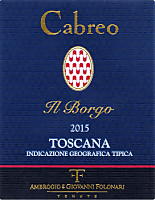
|
|
Cabreo Il Borgo 2015 |
|
| Tenute Folonari (Tuscany, Italy) | |
 Sangiovese (70%), Cabernet Sauvignon (30%) Sangiovese (70%), Cabernet Sauvignon (30%) | |
| Price: € 31.00 | Score: |
 Brilliant ruby red and nuances of garnet red, little transparency. Brilliant ruby red and nuances of garnet red, little transparency. Intense, clean, pleasing, refined and elegant, starts with hints of
black cherry, plum and black currant followed by aromas of violet,
blueberry, raspberry, chocolate, vanilla, tobacco, mace, pink pepper,
leather and eucalyptus. Intense, clean, pleasing, refined and elegant, starts with hints of
black cherry, plum and black currant followed by aromas of violet,
blueberry, raspberry, chocolate, vanilla, tobacco, mace, pink pepper,
leather and eucalyptus.
 Properly tannic attack and however balanced by alcohol, full body,
intense flavors, agreeable. Properly tannic attack and however balanced by alcohol, full body,
intense flavors, agreeable.
 Persistent finish with flavors of black cherry, plum and black currant. Persistent finish with flavors of black cherry, plum and black currant. 18 months in barrique, 6 months in bottle. 18 months in barrique, 6 months in bottle. |
|
 Game, Roasted meat, Braised and stewed meat, Hard cheese Game, Roasted meat, Braised and stewed meat, Hard cheese |
|
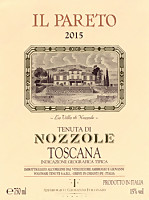
|
|
Il Pareto Tenuta di Nozzole 2015 |
|
| Tenute Folonari (Tuscany, Italy) | |
 Cabernet Sauvignon Cabernet Sauvignon | |
| Price: € 46.00 | Score: |
 Intense ruby red and nuances of ruby red, little transparency. Intense ruby red and nuances of ruby red, little transparency. Intense, clean, pleasing, refined and elegant, starts with hints of
black currant, black cherry and plum followed by aromas of violet,
blueberry, raspberry, tobacco, vanilla, rhubarb, cocoa, graphite, licorice,
leather and eucalyptus. Intense, clean, pleasing, refined and elegant, starts with hints of
black currant, black cherry and plum followed by aromas of violet,
blueberry, raspberry, tobacco, vanilla, rhubarb, cocoa, graphite, licorice,
leather and eucalyptus.
 Tannic attack and however balanced by alcohol, full body, intense
flavors, pleasing roundness. Tannic attack and however balanced by alcohol, full body, intense
flavors, pleasing roundness.
 Persistent finish with flavors of black currant, black cherry and plum. Persistent finish with flavors of black currant, black cherry and plum. 18 months in barrique, at least 6 months in bottle. 18 months in barrique, at least 6 months in bottle. |
|
 Game, Roasted meat, Stewed and braised meat, Hard cheese Game, Roasted meat, Stewed and braised meat, Hard cheese |
|

|
|
Greco di Renabianca 2016 |
|
| Terre Margaritelli (Umbria, Italy) | |
 Grechetto Grechetto | |
| Price: € 15.00 | Score: |
 Intense golden yellow and nuances of golden yellow, very transparent. Intense golden yellow and nuances of golden yellow, very transparent. Intense, clean, pleasing and refined, starts with hints of apple, plum
and hazelnut followed by aromas of hawthorn, citrus fruits, pear, honey,
rosemary and vanilla. Intense, clean, pleasing and refined, starts with hints of apple, plum
and hazelnut followed by aromas of hawthorn, citrus fruits, pear, honey,
rosemary and vanilla.
 Crisp attack and however balanced by alcohol, good body, intense
flavors, pleasing roundness. Crisp attack and however balanced by alcohol, good body, intense
flavors, pleasing roundness.
 Persistent finish with flavors of apple, plum and hazelnut. Persistent finish with flavors of apple, plum and hazelnut. 3 months in barrique, 12 months in bottle. 3 months in barrique, 12 months in bottle. |
|
 Stuffed pasta, Roasted white meat, Roasted fish, Mushroom soups Stuffed pasta, Roasted white meat, Roasted fish, Mushroom soups |
|
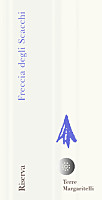
|
|
Torgiano Rosso Riserva Freccia degli Scacchi 2013 |
|
| Terre Margaritelli (Umbria, Italy) | |
 Sangiovese Sangiovese | |
| Price: € 29.00 | Score: |
 Intense ruby red and nuances of garnet red, little transparency. Intense ruby red and nuances of garnet red, little transparency. Intense, clean, pleasing, refined and elegant, starts with hints of
plum, black cherry and dried violet followed by aromas of blueberry,
raspberry, blackberry, tobacco, vanilla, chocolate, mace, cinnamon,
licorice, leather and menthol. Intense, clean, pleasing, refined and elegant, starts with hints of
plum, black cherry and dried violet followed by aromas of blueberry,
raspberry, blackberry, tobacco, vanilla, chocolate, mace, cinnamon,
licorice, leather and menthol.
 Properly tannic attack and however balanced by alcohol, good body,
intense flavors, pleasing roundness. Properly tannic attack and however balanced by alcohol, good body,
intense flavors, pleasing roundness.
 Persistent finish with flavors of plum, black cherry and blackberry. Persistent finish with flavors of plum, black cherry and blackberry. 24 months in barrique, 24 months in bottle. 24 months in barrique, 24 months in bottle. |
|
 Roasted meat, Stewed and braised meat with mushrooms, Hard cheese Roasted meat, Stewed and braised meat with mushrooms, Hard cheese |
|
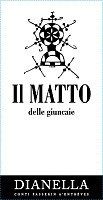
|
|
Il Matto delle Giuncaglie 2015 |
|
| Dianella (Tuscany, Italy) | |
 Sangiovese Sangiovese | |
| Price: € 30.00 | Score: |
 Intense ruby red and nuances of garnet red, little transparency. Intense ruby red and nuances of garnet red, little transparency. Intense, clean, pleasing, refined and elegant, starts with hints of
black cherry, plum and violet followed by aromas of blueberry, raspberry,
blackberry, tobacco, vanilla, chocolate, leather, pink pepper and menthol. Intense, clean, pleasing, refined and elegant, starts with hints of
black cherry, plum and violet followed by aromas of blueberry, raspberry,
blackberry, tobacco, vanilla, chocolate, leather, pink pepper and menthol.
 Properly tannic attack and however balanced by alcohol, full body,
intense flavors, pleasing roundness. Properly tannic attack and however balanced by alcohol, full body,
intense flavors, pleasing roundness.
 Persistent finish with flavors of black cherry, plum and blackberry. Persistent finish with flavors of black cherry, plum and blackberry. 16 months in barrique, at least 6 months in bottle. 16 months in barrique, at least 6 months in bottle. |
|
 Game, Roasted meat, Stewed and braised meat, Hard cheese Game, Roasted meat, Stewed and braised meat, Hard cheese |
|
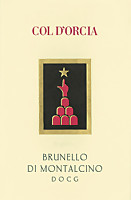
|
|
Brunello di Montalcino 2013 |
|
| Col d'Orcia (Tuscany, Italy) | |
 Sangiovese Sangiovese | |
| Price: € 30.00 | Score: |
 Brilliant ruby red and nuances of garnet red, moderate transparency. Brilliant ruby red and nuances of garnet red, moderate transparency. Intense, clean, pleasing, refined and elegant, starts with hints of
black cherry, plum and raspberry followed by aromas of dried violet,
blueberry, rose, vanilla, chocolate, tobacco, cinnamon, licorice, leather
and menthol. Intense, clean, pleasing, refined and elegant, starts with hints of
black cherry, plum and raspberry followed by aromas of dried violet,
blueberry, rose, vanilla, chocolate, tobacco, cinnamon, licorice, leather
and menthol.
 Tannic attack and however balanced by alcohol, full body, intense
flavors, agreeable. Tannic attack and however balanced by alcohol, full body, intense
flavors, agreeable.
 Persistent finish with flavors of black cherry, plum and blueberry. Persistent finish with flavors of black cherry, plum and blueberry. 3 years in cask, at least 12 months in bottle. 3 years in cask, at least 12 months in bottle. |
|
 Game, Roasted meat, Braised and stewed meat, Hard cheese Game, Roasted meat, Braised and stewed meat, Hard cheese |
|

|
|
Moscadello di Montalcino Pascena Vendemmia Tardiva 2012 |
|
| Col d'Orcia (Tuscany, Italy) | |
 Moscato Bianco Moscato Bianco | |
| Price: € 23.00 - 375ml | Score: |
 Brilliant amber yellow and nuances of amber yellow, transparent. Brilliant amber yellow and nuances of amber yellow, transparent. Intense, clean, pleasing, refined and elegant, starts with hints of
raisin, dried fig and dried apricot followed by aromas of quince jam, date,
peach jam, citrus fruit peel, candied fruits, lychee, lavender, sage,
vanilla and nail polish. Intense, clean, pleasing, refined and elegant, starts with hints of
raisin, dried fig and dried apricot followed by aromas of quince jam, date,
peach jam, citrus fruit peel, candied fruits, lychee, lavender, sage,
vanilla and nail polish.
 Sweet and round attack, however balanced by alcohol, good body, intense
flavors, pleasing crispness. Sweet and round attack, however balanced by alcohol, good body, intense
flavors, pleasing crispness.
 Persistent finish with flavors of raisin, dried fig and dried apricot. Persistent finish with flavors of raisin, dried fig and dried apricot. 12 months in barrique, 6 months in bottle. 12 months in barrique, 6 months in bottle. |
|
 Dried fruit tarts, Confectionery, Hard cheese Dried fruit tarts, Confectionery, Hard cheese |
|

|
|
Montefalco Sagrantino Campo alla Cerqua 2013 |
|
| Tabarrini (Umbria, Italy) | |
 Sagrantino Sagrantino | |
| Price: € 36.00 | Score: |
 Intense ruby red and nuances of ruby red, little transparency. Intense ruby red and nuances of ruby red, little transparency. Intense, clean, pleasing and refined, starts with hints of blackberry,
black cherry and violet followed by aromas of plum, blueberry, raspberry,
tamarind, pink pepper, tobacco, vanilla, chocolate, graphite and menthol. Intense, clean, pleasing and refined, starts with hints of blackberry,
black cherry and violet followed by aromas of plum, blueberry, raspberry,
tamarind, pink pepper, tobacco, vanilla, chocolate, graphite and menthol.
 Tannic attack and however balanced by alcohol, full body, intense
flavors, agreeable. Tannic attack and however balanced by alcohol, full body, intense
flavors, agreeable.
 Persistent finish with flavors of blackberry, black cherry and plum. Persistent finish with flavors of blackberry, black cherry and plum. 36 months in cask, 12 months in bottle. 36 months in cask, 12 months in bottle. |
|
 Game, Roasted meat, Stewed and braised meat, Hard cheese Game, Roasted meat, Stewed and braised meat, Hard cheese |
|

|
|
Montefalco Sagrantino Colle alle Macchie 2013 |
|
| Tabarrini (Umbria, Italy) | |
 Sagrantino Sagrantino | |
| Price: € 45.00 | Score: |
 Intense ruby red and nuances of garnet red, little transparency. Intense ruby red and nuances of garnet red, little transparency. Intense, clean, pleasing, refined and elegant, starts with hints of
blackberry, plum and black cherry followed by aromas of violet, blueberry,
tobacco, cocoa, tamarind, vanilla, mace, graphite, laurel, leather and
menthol. Intense, clean, pleasing, refined and elegant, starts with hints of
blackberry, plum and black cherry followed by aromas of violet, blueberry,
tobacco, cocoa, tamarind, vanilla, mace, graphite, laurel, leather and
menthol.
 Tannic attack and however balanced by alcohol, full body, intense
flavors, pleasing roundness. Tannic attack and however balanced by alcohol, full body, intense
flavors, pleasing roundness.
 Persistent finish with flavors of blackberry, plum and black cherry. Persistent finish with flavors of blackberry, plum and black cherry. 36 months in cask, 12 months in bottle. 36 months in cask, 12 months in bottle. |
|
 Game, Braised and stewed meat, Roasted meat, Hard cheese Game, Braised and stewed meat, Roasted meat, Hard cheese |
|
News |
|
In this section are published news and information about events concerning the world of wine and food. Whoever is interested in publishing this kind of information can send us a mail to our address.
|
AquavitaeReview of Grappa, Distillates and Brandy |
|
|
||||||||||||||
Wine Guide ParadeMarch 2018
|
| |||||||
Privacy Policy | |||||||


| Copyright © 2002-2024 Antonello Biancalana, DiWineTaste - All rights reserved |
| All rights reserved under international copyright conventions. No part of this publication and of this WEB site may be
reproduced or utilized in any form or by any means, electronic or mechanical, without permission in writing from DiWineTaste. |